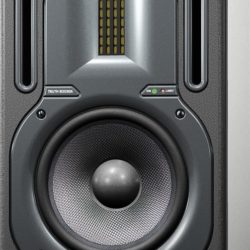An affordable high-resolution, active 2-way reference studio monitor.
The Behringer TRUTH B3030A active monitor speaks nothing but the truth. When it comes to your studio recordings, you want honesty. In fact, considering how important your art is, you should demand it! The TRUTH B3030A monitor also sounds great hooked up to your stereo or your video surround system, but they were really built with studios in mind—where every note you play or sing is under the microscope.
Built on the Behringer Legacy
Behringer TRUTH B2030A monitors have been so wildly successful that they’ve sold thousands upon thousands of them to some of the most critical ears on the planet. So Behringer knew that the B3030A had to be something really special. And they are. Due to their high-resolution performance, B3030A active 2-way reference studio monitors are perfect for nearfield monitoring applications: from small mixing environments to multi-channel surround setups.
Years of R’n’D
For the past two years Behringer’s research and development team has been on a mission to create the “perfect” studio monitor. Since the TRUTH B2031A had already become an industry standard, Behrinhger acoustic engineers decided to start there and see just how far they could push the envelope. They tried a variety of transducers and enclosure designs, along with existing and emerging technologies. When all the dust settled, they chose to deploy an ultra-high resolution, 2″ velocity ribbon transducer and a 6-3/4″ long-throw, Kevlar-coned woofer in a deformation resistant, die-cast aluminum chassis.
Why Kevlar?
Kevlar has an incredible strength-to-weight ratio — that’s one reason it’s used in bulletproof vests. Kevlar gives Behringer’s LF transducer the strength to handle the extremely high energy levels required for distortion-free, chest-pounding bass. And since they have such low mass, Kevlar speaker cones also respond much more quickly than those made of paper, important for not only maintaining bass content integrity, but critical for midrange accuracy and definition. Behringer’s Kevlar transducers reproduce even the subtlest nuance of the low-frequency realm without muddying the midrange.
What’s With the Funny-Looking Tweeter?
Ribbon tweeters bring a level of accuracy and sophistication to high-resolution studio monitors that was previously unattainable. They provide exceptionally wide horizontal dispersion (for a larger “sweet spot”), while holding the vertical dispersion extremely tight. And since Behringer’s ribbon transducer diaphragm is virtually weightless, it reacts instantaneously to changes in the high-frequency content. Now, not only do you hear the dulcet tones of a flute, you hear the breath flowing through it… You hear the wind chimes bouncing off each other… You can hear the fingernails on the nylon strings of a classical guitar…
Another reason why ribbon tweeters are so supremely accurate is their ability to reproduce frequencies far above our normal hearing range. Even though people can’t hear these “ultrasonics,” the lower harmonics they generate do affect the way we experience the stereo image. For instance, a 30 kHz signal is too high for us to hear, but we can hear its first sub-harmonic (15 kHz), second sub-harmonic (7.5 kHz), and third (3.75 kHz), etc. All these sub-harmonics combine with the primary sound to create stunning realism.
Power to the People
It takes quite a bit more than just a “bulletproof” woofer and a high-tech ribbon tweeter stuck inside a fancy box to make a studio monitor of this class. It also takes power — and lots of it! But even more importantly, that power has to be matched to the individual high and low-frequency tranducers. While some of our competitors are content to stick whatever speakers they have on the shelf into haphazardly designed boxes and then strap on a one-size-fits-all amplifier package, we build every single component from the ground up.
Behringer packed 110W of biamped technology (including a time- and phase-corrected active crossover) into every B3030A, ensuring that you have the enormous power reserves you’ll need to drive them really hard
Non-Fatiguing, Wide “Sweet Spot”
B3030A’s HF (High Frequency) content comes courtesy of an ultra high-resolution 1.0″ ferrofluid-cooled tweeter mounted on Behringer’s proprietary wave-guide. While some of Behringer’s competitor’s studio monitors have a highly focused “sweet spot” (the optimal listening position for a pair of loudspeakers), Behringer’s wave-guide is designed to create a much more generous, broader listening zone. That means you won’t wear a hole in the carpet in that one spot where everything sounds great. You are free to move around inside the stereo image to find the ideal spot in the mix for subtle instrument or effects placement opportunities.
You also won’t suffer the ravages of “monitor fatigue-syndrome,” an ailment that comes from listening to harsh high-mids and treble content for hours on end, even during those all-night mix-down sessions that can really test your nerves.






Join the discussion
comments powered by Disqus